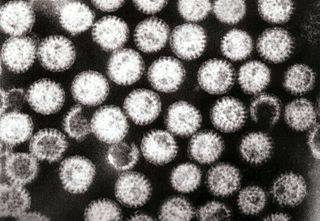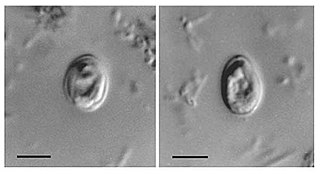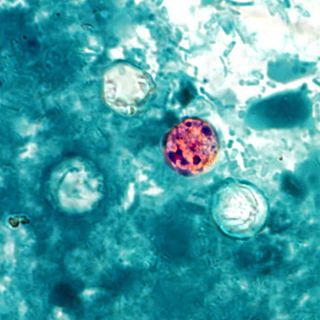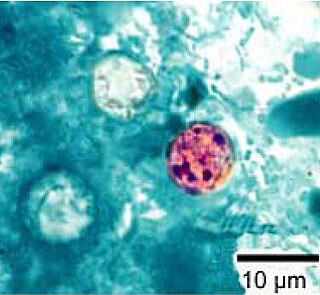Cryptosporidiosis is a parasitic disease caused by Cryptosporidium . It can be spread by water or contact with contaminated surfaces. [1]
Cryptosporidiosis is a parasitic disease caused by Cryptosporidium . It can be spread by water or contact with contaminated surfaces. [1]
| Year | Location | Number of cases | Outbreak source | Link to article | References |
|---|---|---|---|---|---|
| 1996 | Cranbrook | 2,000 | [2] | ||
| 1996 | Kelowna | 10,000–15,000 | [2] |
| Year | Location | Number of cases | Outbreak source | Link to article | References |
|---|---|---|---|---|---|
| 1995 | Emilia-Romagna | 294 | [3] | ||
| 2019 | Tuscan–Emilian Apennines | 75 | [4] |
| Year | Location | Number of cases | Outbreak source | Link to article | References |
|---|---|---|---|---|---|
| 1995 | Tauranga | 1 | School | [5] | |
| 1997 | Waikato | 170 | [5] | ||
| 1997 | Tauranga | Unknown | [6] | ||
| 2003 | Masterton | "Few" | Water supply | [5] | |
| 2010 | Auckland | 7 | Swimming pool | [7] | |
| 2010 | Christchurch | 17 | Unknown | [7] | |
| 2013 | Hawke's Bay | 22 | Swimming pool | [7] | |
| 2013 | Waikato | 5 | Unknown | [7] | |
| 2013 | Wellington | 5 | Unknown | [7] | |
| 2013 | Taranaki | 3 | Unknown | [7] | |
| 2015 | Auckland | 6 | Raw milk | [7] | |
| 2017 | Auckland | 9 | Childcare centre | [7] | |
| 2018 | Kāpiti Coast | 11 | Water playground | [8] | |
| 2021 | Taranaki | 6 | Raw milk | [7] | |
| 2021 | Taranaki | 4 | Raw milk | [7] | |
| 2023 | Queenstown | 18 as of 21 September 2023 [update] | Unknown | Queenstown cryptosporidiosis outbreak | [9] |
| Year | Location | Number of cases | Outbreak source | Link to article | References |
|---|---|---|---|---|---|
| 1989 | Oxfordshire | 500 | Discovered in filters at Farmoor Reservoir [10] | [11] | |
| 1995 | Torbay | 508 | [12] | ||
| 2024 | Brixham | 100 | [15] |
| Year | Location | Number of cases | Outbreak source | Link to article | References |
|---|---|---|---|---|---|
| 2019 | Pasco County | 10 | [16] |
| Year | Location | Number of cases | Outbreak source | Link to article | References |
|---|---|---|---|---|---|
| 1987 | Carroll County | 13,000 | 1987 Carroll County cryptosporidiosis outbreak | [17] |
| Year | Location | Number of cases | Outbreak source | Link to article | References |
|---|---|---|---|---|---|
| 1993 | Milwaukee | 403,000 | 1993 Milwaukee cryptosporidiosis outbreak | [18] |

Diarrhea, also spelled diarrhoea or diarrhœa, is the condition of having at least three loose, liquid, or watery bowel movements in a day. It often lasts for a few days and can result in dehydration due to fluid loss. Signs of dehydration often begin with loss of the normal stretchiness of the skin and irritable behaviour. This can progress to decreased urination, loss of skin color, a fast heart rate, and a decrease in responsiveness as it becomes more severe. Loose but non-watery stools in babies who are exclusively breastfed, however, are normal.

Norovirus, also known as Norwalk virus and sometimes referred to as the winter vomiting disease, is the most common cause of gastroenteritis. Infection is characterized by non-bloody diarrhea, vomiting, and stomach pain. Fever or headaches may also occur. Symptoms usually develop 12 to 48 hours after being exposed, and recovery typically occurs within one to three days. Complications are uncommon, but may include dehydration, especially in the young, the old, and those with other health problems.

Drinking water or potable water is water that is safe for ingestion, either when drunk directly in liquid form or consumed indirectly through food preparation. It is often supplied through taps, in which case it is also called tap water. Typically in developed countries, tap water meets drinking water quality standards, even though only a small proportion is actually consumed or used in food preparation. Other typical uses for tap water include washing, toilets, and irrigation. Greywater may also be used for toilets or irrigation. Its use for irrigation however may be associated with risks.

Cryptosporidiosis, sometimes informally called crypto, is a parasitic disease caused by Cryptosporidium, a genus of protozoan parasites in the phylum Apicomplexa. It affects the distal small intestine and can affect the respiratory tract in both immunocompetent and immunocompromised individuals, resulting in watery diarrhea with or without an unexplained cough. In immunosuppressed individuals, the symptoms are particularly severe and can be fatal. It is primarily spread through the fecal-oral route, often through contaminated water; recent evidence suggests that it can also be transmitted via fomites contaminated with respiratory secretions.

Giardiasis is a parasitic disease caused by Giardia duodenalis. Infected individuals who experience symptoms may have diarrhoea, abdominal pain, and weight loss. Less common symptoms include vomiting and blood in the stool. Symptoms usually begin one to three weeks after exposure and, without treatment, may last two to six weeks or longer.

Campylobacteriosis is among the most common infections caused by a bacterium in humans, often as a foodborne illness. It is caused by the Campylobacter bacterium, most commonly C. jejuni. It produces an inflammatory, sometimes bloody, diarrhea or dysentery syndrome, and usually cramps, fever and pain.

Cryptosporidium parvum is one of several species that cause cryptosporidiosis, a parasitic disease of the mammalian intestinal tract.

Cryptosporidium, sometimes called crypto, is an apicomplexan genus of alveolates which are parasites that can cause a respiratory and gastrointestinal illness (cryptosporidiosis) that primarily involves watery diarrhea, sometimes with a persistent cough.
Wilderness-acquired diarrhea is a variety of traveler's diarrhea in which backpackers and other outdoor enthusiasts are affected. Potential sources are contaminated food or water, or "hand-to-mouth", directly from another person who is infected. Cases generally resolve spontaneously, with or without treatment, and the cause is typically unknown. The National Outdoor Leadership School has recorded about one incident per 5,000 person-field days by following strict protocols on hygiene and water treatment. More limited, separate studies have presented highly varied estimated rates of affliction that range from 3 percent to 74 percent of wilderness visitors. One survey found that long-distance Appalachian Trail hikers reported diarrhea as their most common illness. Based on reviews of epidemiologic data and literature, some researchers believe that the risks have been over-stated and are poorly understood by the public.

Cyclosporiasis is a disease caused by infection with Cyclospora cayetanensis, a pathogenic apicomplexan protozoan transmitted by feces or feces-contaminated food and water. Outbreaks have been reported due to contaminated fruits and vegetables. It is not spread from person to person, but can be a hazard for travelers as a cause of diarrhea.

Cyclospora cayetanensis is a coccidian parasite that causes a diarrheal disease called cyclosporiasis in humans and possibly in other primates. Originally reported as a novel pathogen of probable coccidian nature in the 1980s and described in the early 1990s, it was virtually unknown in developed countries until awareness increased due to several outbreaks linked with fecally contaminated imported produce. C. cayetanensis has since emerged as an endemic cause of diarrheal disease in tropical countries and a cause of traveler's diarrhea and food-borne infections in developed nations. This species was placed in the genus Cyclospora because of the spherical shape of its sporocysts. The specific name refers to the Cayetano Heredia University in Lima, Peru, where early epidemiological and taxonomic work was done.

Influenza A virus subtype H1N2 (A/H1N2) is a subtype of the species Influenza A virus. It is currently endemic in pig populations and is occasionally seen in humans.

Waterborne diseases are conditions caused by pathogenic micro-organisms that are transmitted by water. These diseases can be spread while bathing, washing, drinking water, or by eating food exposed to contaminated water. They are a pressing issue in rural areas amongst developing countries all over the world. While diarrhea and vomiting are the most commonly reported symptoms of waterborne illness, other symptoms can include skin, ear, respiratory, or eye problems. Lack of clean water supply, sanitation and hygiene (WASH) are major causes for the spread of waterborne diseases in a community. Therefore, reliable access to clean drinking water and sanitation is the main method to prevent waterborne diseases.
The 1993 Milwaukee cryptosporidiosis outbreak was a significant distribution of the Cryptosporidium protozoan in Milwaukee, Wisconsin, and the largest waterborne disease outbreak in documented United States history. It is suspected that The Howard Avenue Water Purification Plant, one of two water treatment plants in Milwaukee at the time, was contaminated. It is believed that the contamination was due to an ineffective filtration process. Approximately 403,000 residents were affected resulting in illness and hospitalization. Immediate repairs were made to the treatment facilities along with continued infrastructure upgrades during the 25 years since the outbreak. The total cost of the outbreak, in productivity loss and medical expenses, was $96 million. At least 69 people died as a result of the outbreak. The city of Milwaukee has spent upwards to $510 million in repairs, upgrades, and outreach to citizens.
Cryptosporidium hominis, along with Cryptosporidium parvum, is among the medically important Cryptosporidium species. It is an obligate parasite of humans that can colonize the gastrointestinal tract resulting in the gastroenteritis and diarrhea characteristic of cryptosporidiosis. Unlike C. parvum, which has a rather broad host range, C. hominis is almost exclusively a parasite of humans. As a result, C. hominis has a low zoonotic potential compared to C. parvum. It is spread through the fecal-oral route usually by drinking water contaminated with oocyst laden feces. There are many exposure risks that people can encounter in affected areas of the world. Cryptosporidium infections are large contributors of child death and illness in heavily affected areas, yet low importance has been placed on both identifying the species and finding more treatment options outside of nitazoxanide for children and AIDS patients.
The Long Term 2 Enhanced Surface Water Treatment Rule is a 2006 regulation promulgated by the United States Environmental Protection Agency (EPA) pursuant to the Safe Drinking Water Act. The rule required public water systems to install more stringent treatment systems to control the microorganism Cryptosporidium and other pathogens.

Legionnaires' disease is a form of atypical pneumonia caused by any species of Legionella bacteria, quite often Legionella pneumophila. Signs and symptoms include cough, shortness of breath, high fever, muscle pains, and headaches. Nausea, vomiting, and diarrhea may also occur. This often begins 2–10 days after exposure.
The 1987 Carroll County cryptosporidiosis outbreak was a significant distribution of the Cryptosporidium protozoan in Carroll County, Georgia. Between January 12 and February 7, 1987, approximately 13,000 of the 65,000 residents of the county suffered intestinal illness caused by the Cryptosporidium parasite. Cryptosporidiosis is characterized by watery diarrhea, stomach cramps or pain, dehydration, nausea, vomiting and fever. Symptoms typically last for 1–4 weeks in immunocompetent individuals.
Una M. Ryan is a biochemist from Ireland, researching parasites and infectious agents in Australia, where she lives. She is an associate professor at the School of Veterinary and Biomedical Sciences of Murdoch University. In 2000, she received the Frank Fenner Prize for Life Scientist of the Year from the Prime Minister of Australia for her work in isolating a method of diagnosing parasites.
In September 2023, an outbreak of cryptosporidiosis, a parasitic illness, started in Queenstown, New Zealand. It was Queenstown's first gastroenteritis outbreak in 40 years. Queenstown issued a water boil notice on 18 September, which ended on 8 December. The most probable cause of the outbreak was human fecal matter. During the outbreak, district mayor Glyn Lewers was concerned with how it would impact the town's reputation. As of 24 September, most cases are between the ages of 15 and 39, but there has been a case under the age of 10. As of 29 September 2023, three people had been hospitalised, all of whom had been discharged.
Thames Water have announced an independent inquiry into the water scare in Oxfordshire which led to thousands of households being told to boil their drinking water. The warning, which is not yet lifted, came after the diarrhoea-linked bug, Cryptosporidium, was found in filters at the giant Farmoor water works outside Oxford.
The bug, Cryptosporidium, laid low more than 500 people in January with diarrhoea and illness which can kill those with weak immune systems.
South West Water confirmed a 'boil-your-water' alert to 200,000 South Devon householders after a Cryptosporidium bug was found to be the cause of an outbreak of stomach upsets.
The number of confirmed cases of stomach upsets caused by the water bug Cryptosporidium almost doubled overnight with today's total now standing at 91.
The number of officially recorded victims of the bug topped 508 today.